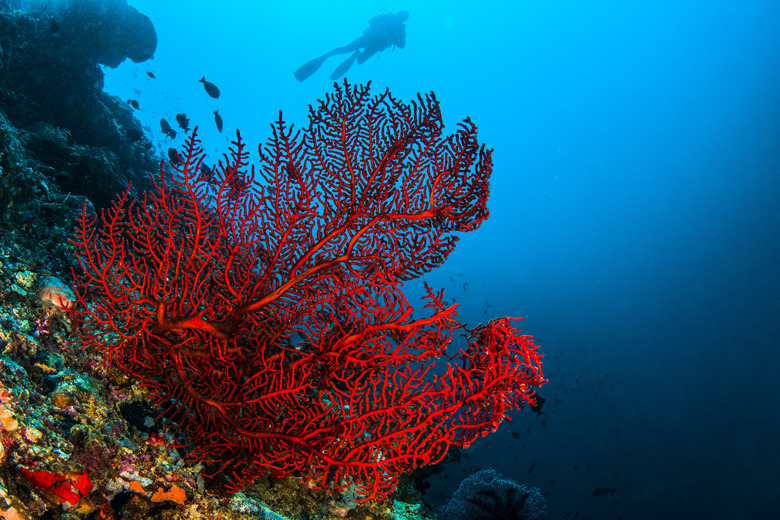Trophic Levels Of Coral Reefs
A coral reef is a diverse environment that encompasses a wide-ranging food web. Trophic levels in a coral reef describe the feeding position of the plants and animals that make up that ecosystem. Plants, which are able to create their own energy, are primary producers. Herbivores, creatures that eat primary producers, make up the second level. Carnivores occupy the final levels.
Primary Producers
Primary Producers
Primary producers form the basis of the coral reef ecosystem. Mostly made up of sea plants, this group produces its own food and therefore does not rely on another animal or plant for survival. Most primary producers are photosynthetic, meaning they convert energy from the sun for their own subsistence.
Phytoplankton, coralline algae and seaweed are photosynthetic primary producers that commonly inhabit the coral reef. In deep reef areas that lack sunlight, producers perform chemosynthesis to make their own food. These organisms are able to convert inorganic compounds, such as ferrous iron and hydrogen sulfide, into usable energy. Archaea are one example; these single-celled microorganisms sustain themselves by a process of chemical conversion in the darkest of coral reefs.
Primary Consumers
Primary Consumers
Primary consumers rely on primary producers for sustenance. These are the herbivores in the ecosystem. Herbivorous zooplankton, the most plentiful of the primary consumers, are small sea organisms. Zooplankton span a wide range of organisms. Some float along the surface of the ocean, others are able to swim and still others are the young of larger animals.
The flounder is an example of a fish that begins life as zooplankton. Infant flounder cannot swim, so they float and feed on plankton. Once the flounder matures into a fish, however, it settles to the ocean floor and is no longer restricted to a herbivorous diet. Other primary consumers include gastropods, such as sea snails, sponges and sea urchins. Larger species, such as herbivorous crabs and green sea turtles are primary consumers. Herbivorous fish such as parrotfish, surgeonfish and triggerfish and make their homes in the coral reef.
Secondary Consumers
Secondary Consumers
Secondary consumers eat primary consumers. These are carnivorous animals that are also eaten by carnivores. Some sea animals, such as butterflyfish, parrotfish, filefish and coral guard crabs consume coral and are subsequently called corallivores.
Lobsters and mantis shrimp subsist on benthic invertebrates, which are animals that live on the ocean floor and lack backbones. Examples of benthic invertebrates include mollusks, anemones and various types of worms. Secondary consumers that eat fish are called piscivores. Fish, mollusks and arthropods are examples of secondary consumers that are piscivores.
Tertiary Consumers
Tertiary Consumers
At the top trophic levels lie the tertiary consumers. Also called apex predators, tertiary consumers are carnivores that are not preyed upon themselves. Quick and agile swimmers and skilled hunters, apex predators include sharks, dolphins, tuna and seals. These animals are often large in size. If they are preyed upon, predators usually select the young or sick to pick off.
Cite This Article
MLA
Peck, Andrea. "Trophic Levels Of Coral Reefs" sciencing.com, https://www.sciencing.com/trophic-levels-coral-reefs-5523723/. 21 May 2018.
APA
Peck, Andrea. (2018, May 21). Trophic Levels Of Coral Reefs. sciencing.com. Retrieved from https://www.sciencing.com/trophic-levels-coral-reefs-5523723/
Chicago
Peck, Andrea. Trophic Levels Of Coral Reefs last modified March 24, 2022. https://www.sciencing.com/trophic-levels-coral-reefs-5523723/
